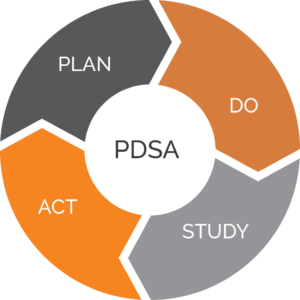We’re continuing our Plan-Do-Study-Act (PDSA) series, and today are taking a closer look at “Do” and “Study.” As a reminder, the PDSA framework helps organizations implement a Continuous Quality Improvement (CQI) process. You can find a complete overview of PDSA in this blog and this video. We break down “Plan” here.

Do
Now that you have a clear plan, with an aim statement, planning diagram, process map, and data collection plan, it is time to implement your intervention.
Most organizations know and are already doing this step in the process. Organizations deliver interventions daily with their services, intentionally or unintentionally. What makes the “Do” step in this process transformational is wrapping it around the other three steps to guide the work and understand the impact.
Before you begin implementation, ensure you have thoroughly reviewed your process map to understand all the steps in the process your intervention will impact. Be sure, too, that you have detailed all the data points you will need to collect to fully answer your questions and measure your impact.
Before fully implementing, make sure you have completed the following steps:
- Create or update policies and procedures and communicate to all staff participating in the process you plan to change. Use your process map to understand which team will be involved in implementing the change and how.
- Develop or update data collection tools to make your data collection plan possible.
- Meet with staff to inform them of changes made. It can be helpful to explain the process up to this point so the team understands the importance of the implementation in the broader CQI framework. Remember, the “Do” step is only practical if all staff are on board and implement the change as planned.
- Train staff on how to implement changes. Remember that even small routine changes can sometimes be challenging to adjust to. Ensure all team knows the intervention and their responsibilities before implementing any planned changes.
Once these steps are complete, carry out your intervention. For the duration of the planned intervention, ensure changes remain in action – it can be easy to fall back into old habits!
Throughout implementation, collect data to understand your intervention’s impact per your data collection plan. Your team should also document problems, unexpected effects, and general observations as you go.
Study
The study phase of the cycle occurs after you have completed your intervention. You then analyze the data to study what did or did not occur. Organizations will want to review their predictions and assumptions before conducting the test.
- Complete data analysis
- Compare data to predictions
- Summarize the information
Organizations often skip over this step in the process or need to spend more time thoughtfully reviewing the data. For some organizations, their data can be considered “high stakes,” There is a tendency to focus on the positive changes/ results that occurred and glance over the changes that did not happen or the benchmarks that were not met. During this phase, it is so important for an organization to be transparent and honest with themselves when reviewing the data. Remember, Continuous Quality Improvement is all about learning. Often, we know just as much when interventions do not have the effects we thought they would like as when they do.
First, complete the data analysis. As you analyze, compare the data you see to your predictions outlined in the “Plan” phase. Use your research to answer the following questions:
- Did your plan result in an improvement? By how much/little?
- Was the action worth the investment?
- Do you see trends?
- Were there unintended side effects?
- What is interesting?
- What questions does this raise for us?
- What is significant about this information?
- What else do we want to know?
- Is this the correct data?
- Is it meaningful?
- How does it tie back to who we serve/ support?
- How does it address our mission and cause?
In your analysis, pair your data with staff observations, and pay special attention to data that is surprising or seems contradictory; examine these pieces and use your team’s expertise to understand why they make sense.
Based on your data, create a summary of your findings. Explain what happened and why you think the intervention had the impact it did. Keep in mind that the “Study” phase might reveal new questions. Note these for further analysis. Some findings may open the door to a new PDSA cycle. These questions are valuable takeaways from the process as well!
In the next step of the Continuous Quality Improvement PDSA process, we will explore what to do with what you have learned: the “Act” step.
At Transform Consulting Group, we follow this consistent approach when helping you find solutions to accelerate your impact. If you want to improve the quality of a service or program to facilitate positive change, contact us today!





